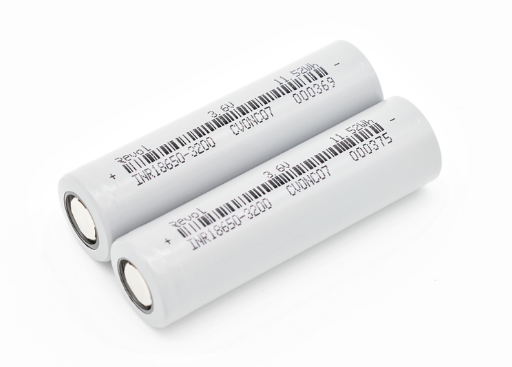Everything You Need to Know About Cylindrical Batteries
Cylindrical batteries can be categorized based on their filler materials into several types: lithium iron phosphate batteries, lithium cobalt oxide batteries, lithium manganese oxide batteries, and cobalt-manganese hybrid batteries. Additionally, cylindrical lithium batteries are differentiated by their shell types, which include steel shell lithium batteries and polymer shell lithium batteries.
Part 1: Characteristics of Cylindrical Batteries
1. Appearance of Cylindrical Lithium Batteries
Cylindrical lithium batteries typically consist of a positive electrode material (such as nickel-cobalt oxide or zinc-manganese oxide), separator paper, and an electrolyte. The battery casing is usually made from an aluminum-plastic composite pipe.
2. Capacity of Cylindrical Lithium Batteries
The rated energy density of a single cylindrical lithium battery ranges from 300 to 500 Wh/kg, with a specific power exceeding 100 W. The actual performance can vary depending on the model and specifications of the battery.
3. Safety and Reliability of Cylindrical Lithium Batteries
Cylindrical lithium batteries are known for their high safety and stability. They exhibit resistance to overcharging, high temperatures, and offer a long service life.
4. Applications of Cylindrical Lithium Batteries
Cylindrical lithium batteries are commonly used as power sources in various devices, including digital cameras, MP3 players, laptops, car starters, power tools, and other portable electronic products.
Part 2: Structure of Cylindrical Batteries
A standard cylindrical lithium-ion battery is composed of several key components: a casing, a cap, a positive electrode, a negative electrode, a separator, and an electrolyte. In this design, the casing typically serves as the negative electrode, while the cap functions as the positive electrode. The casing is usually made from nickel-plated steel.
The primary distinction between power cylindrical batteries and standard cylindrical batteries lies in their conductive connection structure. Power cylindrical batteries require a specialized high-current design to accommodate the relatively large application currents typical of power applications.
Part 3: 7 Common Types of Cylindrical Batteries
Cylindrical lithium batteries typically have a five-digit model number. From left to right, the first and second digits indicate the battery diameter, the third digit represents the battery height, and the fifth digit denotes the series.
Common cylindrical lithium battery models include 10440, 14500, 16340, 18650, 21700, 26650, and 32650.
1. 10440 Battery
The 10440 battery is a lithium battery with a diameter of 10 mm and a height of 44 mm, equivalent in size to what is often called an AA battery. Its capacity is generally quite small, only a few hundred mAh. This battery is primarily used in compact electronic devices, such as flashlights, mini audio equipment, and speakers.
2. 14500 Battery
The 14500 battery features a diameter of 14 mm and a height of 50 mm, with a typical voltage of 3.7V or 3.2V. It has a nominal capacity slightly larger than the 10440 battery, usually around 1600 mAh. The 14500 battery offers excellent discharge performance and is commonly used in consumer electronics, including wireless audio devices, electric toys, and digital cameras.
3. 16340 Battery
The 16340 battery has a diameter of 16 mm and a height of 34 mm. This battery is frequently used in bright flashlights, LED flashlights, headlamps, laser pointers, and lighting lamps. Due to its shorter height, the 16340 battery has a smaller capacity.
4. 18650 Battery
The 18650 battery measures 18 mm in diameter and 65 mm in height. It is known for its high energy density, nearly reaching 170 Wh/kg, making it a cost-effective choice. This type of battery is commonly seen in various applications, including mobile phones, laptops, and other small devices, due to its reliability and mature technology. The 18650 battery is widely used in battery packs with capacities around 10 kWh.
5. 21700 Battery
The 21700 battery has a diameter of 21 mm and a height of 70 mm. Its increased volume allows for higher energy density compared to the 18650 battery, making it suitable for a range of applications, such as digital devices, electric vehicles, balance bikes, solar-powered street lights, LED lights, and power tools.
6. 26650 Battery
The 26650 battery features a diameter of 26 mm and a height of 65 mm, with a nominal voltage of 3.2V and a nominal capacity of 3200 mAh. Known for its excellent capacity and high consistency, the 26650 battery is becoming a popular alternative to the 18650 battery, particularly in power applications.
7. 32650 Battery
The 32650 battery is a lithium-ion battery with a diameter of 32 mm and a height of 65 mm. It boasts strong continuous discharge capabilities, making it suitable for electric toys, backup power supplies, UPS systems, and wind power generation systems.
Part 4: Cylindrical Battery Voltage, Capacity, Charger, and PCB
1. Rated Voltage of Cylindrical Battery Cells
3.7V / 3.2V
2. Cylindrical Battery Cell Capacity
Common cylindrical battery cell capacities are as follows:
- 10440 battery cell nominal capacity: 320mAh
- 14430 battery cell nominal capacity: 500mAh - 700mAh
- 14500 battery cell nominal capacity: 600mAh - 800mAh
- 14650 battery cell nominal capacity: 1100mAh
- 16340 battery cell nominal capacity: 700mAh
- 18350 battery cell nominal capacity: 900mAh
- 18500 battery cell nominal capacity: 1200mAh - 1600mAh
- 18650 battery cell nominal capacity: 1000mAh, 1200mAh, 1500mAh, 1800mAh, 2000mAh, 2200mAh, 2500mAh, 2600mAh, 2900mAh, 3000mAh, 3250mAh, etc.
- 21700 battery cell nominal capacity: 4000mAh, 4500mAh, 4800mAh, etc.
- 26650 battery cell nominal capacity: 3000mAh, 3300mAh, 3400mAh, etc.
- 32650 battery cell nominal capacity: 6000mAh, etc.
3. Cylindrical Battery Pack Voltage
Common cylindrical battery pack voltages: 3.2V, 3.7V, 6.4V, 7.4V, 9.6V, 11.1V, 12V, 14.8V, 22.2V, 24V, 36V, 48V, etc.
4. Cylindrical Battery Pack Capacity
Common cylindrical battery pack capacities: 2Ah, 4Ah, 5Ah, 6Ah, 8Ah, 10Ah, 12Ah, 15Ah, 20Ah, etc.
5. Cylindrical Battery Charger
Chargers for cylindrical batteries should be selected based on the specific battery pack; there is no universal charger.
6. Cylindrical Battery PCB
Most cylindrical batteries include PCB protection features such as overcharge protection, overdischarge protection, short circuit protection, overcurrent protection, and overheating protection to ensure battery safety.


